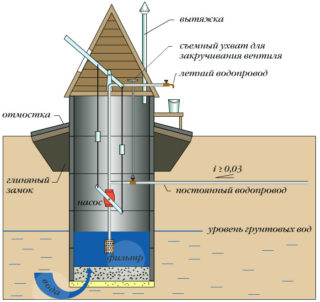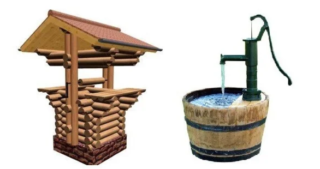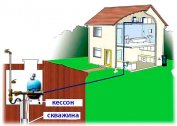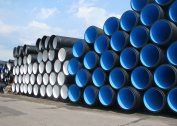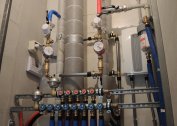To equip autonomous water supply in a suburban area, it is necessary to install an individual source - a well or a well. Each of them is distinguished by a number of its pros and cons. Therefore, the choice is only for the master according to the list of criteria important to him.
A brief comparative analysis of the well and the well
Structurally, both sources differ from each other. A well is a narrow shaft with a diameter of 70 mm to 130 mm. Its depth can reach 250 meters. For wells with a depth of 50 m or more, a special license is required. This is an artesian spring with mineral water. Resource extraction is carried out using deep pumping equipment.
The well is a wider shaft from 70 cm with a depth of 15 m. From such an autonomous source, you can lift water using a surface or submersible pump, or manually.
The quality of a resource from a well and a well always varies. Water in the first comes from the upper layers. And this means that it can be contaminated with industrial effluents, nitrates, bacteria and sewage microorganisms. The fluid from the well often comes with an admixture of a large amount of minerals, salts of heavy metals, iron, sand. But still the best.
Advantages and disadvantages
To understand what is better - a well or a well in the country, their pros and cons should be indicated.
Well
It has such main advantages:
- lower costs for arranging the source;
- the possibility of self-service and repair if necessary;
- clear operation;
- lack of need for the use of special equipment at the site when installing the source.
The disadvantages of the well include:
- lower productivity (about 1-2 m3 / h) in comparison with the well;
- dubious water quality (depends on the location of the suburban area);
- drop in flow rate in the heat season;
- the need for regular cleaning and disinfection.
Water from a well depends on precipitation. Often an aquifer resource is mixed with groundwater.
Well
For a deeper source, these advantages are characteristic:
- quick installation using special equipment;
- better fluid quality;
- takes up little space on the site;
- high productivity (3-5 m3 / hour).
The minuses of the source include:
- difficulty in maintaining or repairing;
- the need for expensive downhole pumping equipment;
- financial costs for the construction of the well;
- the complexity of its installation on quicksand;
- risk of exposure to highly mineralized water;
- the need to install good filtering equipment.
It is unlikely that it will be possible to drill a well on its own. Here it is necessary to conduct geological surveys and an exclusively professional approach.
The main differences in important parameters
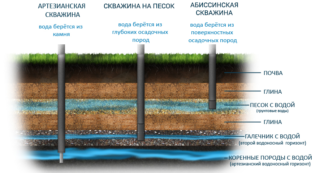 Both types of sources have a number of distinctive characteristics. It is for them that the master subsequently makes the final choice in favor of one or the other. First of all, it is important to pay attention to the depth of the aquifer. There are three main types:
Both types of sources have a number of distinctive characteristics. It is for them that the master subsequently makes the final choice in favor of one or the other. First of all, it is important to pay attention to the depth of the aquifer. There are three main types:
- High vault. This is the smallest source organization. The depth of the formation is 4-5 meters. The simplest Abyssinian well (igloo-well) is made at this level. Water here has the lowest quality, as it absorbs all the upper drains.
- Soil layer. It is located approximately at the level of 10-13 meters.The liquid here is cleaner due to the passage of multi-level natural filtration (sand, limestone, clay layers).
- Artesian strata. They are localized below the 40 m mark. This resource is considered as clean and suitable for drinking.
The well is best done to a depth of more than 10 meters. Then you can safely use the building for household and domestic purposes.
Cost of sources
Drilling a well will be somewhat cheaper if reinforced concrete rings are used when installing the well. Moreover, for the installation of each subsequent (after 10 pcs.), You will still have to pay extra from above. The meter for drilling a well does not change depending on the depth of the source.
It is worth considering that for the installation of a well you can use your own forces, while only specialists can drill a well. And this is a big expense.
Source stability
As for the flow rate, it is less constant for the well than for the well. Especially if the first is dug on the tip. Here, the water level will constantly drop under the condition of summer drought.
Volatility
A well is more advantageous here, since water can be taken from it either with a pump or manually. From the well, liquid is raised only by means of pumping equipment. To provide the house with water from their wells in the absence of electricity, you will have to install either an autonomous generator or a large storage accumulator. And this is an additional cost.
Source Life
Both the well and the well are able to work for more than 20-25 years with their correct arrangement. However, they can fail under adverse conditions. Here the odds are completely equalized. There are no differences in terms of operation.
How to choose a source type
What is better for private houses - a well or a well, the master determines, based on such criteria:
- Purpose of using water. If it is needed only for a summer residence (watering, irrigation, washing), it is more convenient to build a small high-water well or a needle-well. For drinking, it is better to mount a deeper source.
- Seasonality of the use of a well or well. If permanent residence in the house is supposed, it is better to mount a deeper, thorough hydraulic construction. Wells with a depth of 8-12 meters will be enough for summer water use.
- Depth of the reservoir in the area. If it is located below the 15 m mark, it is better to drill a well. Digging a well to such a depth and then arranging it is impractical.
- Finance. Well construction is cheaper than installing a well.
- Technical difficulties. When installing a well, you will have to “pat” an already well-maintained area. In turn, the digging of the well is an impressive amount of the selected soil that needs to be attached somewhere.
In order to finally determine the type of source on the site, it is advisable to bypass the neighbors, find out what is the depth of their wells, wells and how things are going with flow rates in summer. The services of professionals will be useful. Pre-drilling is a cost. But experts will determine the type of source needed for the specific goals and capabilities of the site.
Owner reviews
Judging by the reviews of the owners, each type of hydraulic structure is good for specific situations.
Nikolay, 43 years old. Personally, I bought a house with a well. Its depth was ridiculous - about 8 m. No water quality. There was also a smell. I did not choose for a long time and decided to drill. Invited specialists. We identified the nearest aquifer with good water at the level of 28 meters. Drilling took a day. Then pumping the source. It all took no more than a week with the arrangement and installation of pumping equipment. The well has been operating for the third year. Productivity - about 4 m3 / hour. The house on two floors and plus a garden are supplied from this building. The difference in water quality is enormous, of course.
Yura, 39 years old. I have a country house with one room and a kitchen. Most often we use it as a summer pension.There is no water supply to the village, so everyone made his own sources. Who has a well, who has an abyssine. I decided to try the second option. Drilled independently with a drill at 8 meters and reached an aquifer. Put a narrow pipe with a filter. For the winter, I canned the system.
Ilya, 35 years old. The well decided to dig on the site as soon as he bought it. Followed the example of the neighbors. Digging with the godfather to a depth of 12 meters. Stacked in 10 concrete rings. I laid out the rest with brick (I stayed from the old house). Water comes clean (handed over for analysis). There is a small admixture of sand and metal salts. But he put the reverse osmosis unit on drink. There is water constantly, even in summer in the heat. The well has been working for the fourth year.

